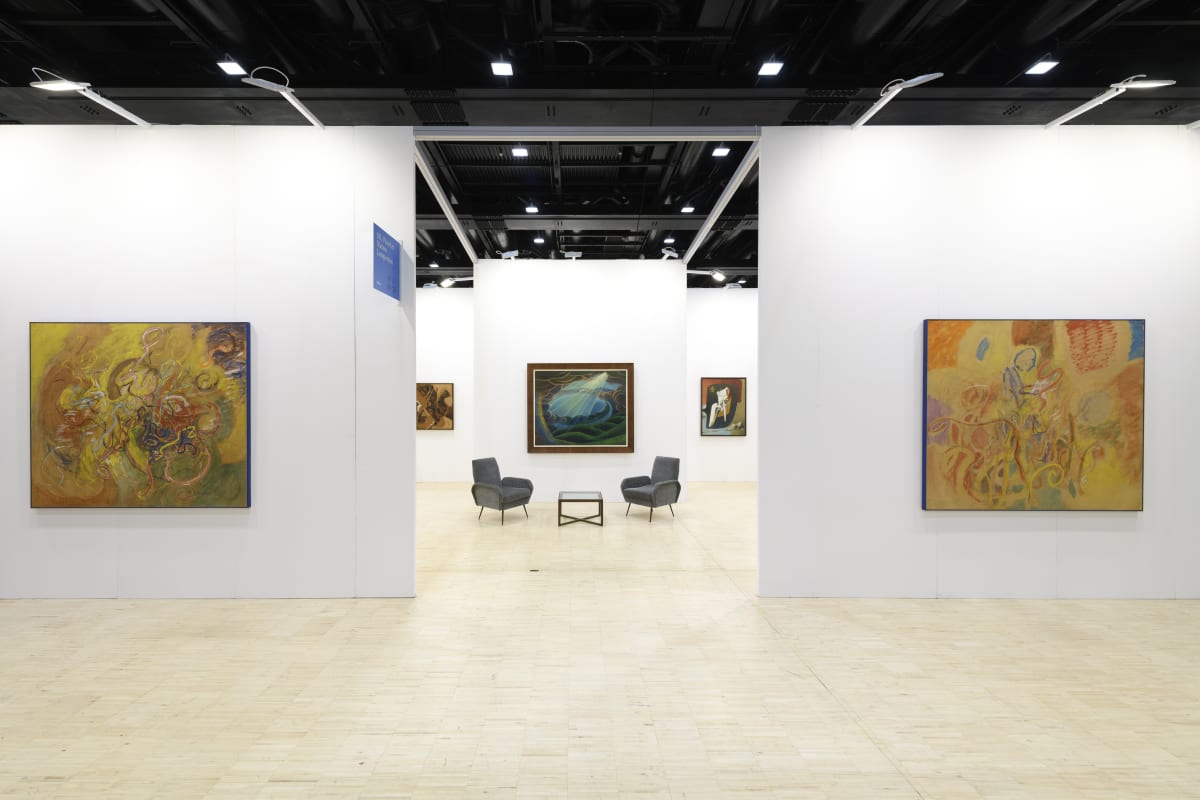Enrico Prampolini Italian, 1894-1956
Overview
Italian painter, set designer, art writer. He was one of the best known representatives of Futurism, to which he adhered from 1912, contributing 'manifestos' and polemical writings, characterising his research from the very beginning by favouring polymateric collage as a means of expression. After a preparatory period in which he assimilated, along with Futurist elements, those of Cubism and abstractionism (e.g. Architecture of the Tarantella, 1922, Łodź, Art Museum; Mechanical Dance, 1924), he gradually moved through purely abstract forms and polymateric media towards a representation of fantastical visions of strong luminosity, cosmic objects and bodies, symbolising the power of the human spirit over natural forces, through the means of modern civilisation and its interpenetration with them (e.g. The Magic of the Stratosphere, 1931; Geological Metamorphosis, 1933; Solar Painting, 1939, etc.). In contact with the major avant-garde movements of the 20th century, he played an important role as an organiser of events. His theoretical contribution in the field of theatre scenography was also interesting.
Works
-
 L'heure du Fantoche, 1926
L'heure du Fantoche, 1926 -
 Grotta verde. Architettura dello spazio, 1928
Grotta verde. Architettura dello spazio, 1928 -
 Materia Cosmica , 1929
Materia Cosmica , 1929 -
 Analogie plastiche , 1930
Analogie plastiche , 1930 -
 Composizione (Polimetria), 1930
Composizione (Polimetria), 1930 -
 Continenti Cosmici , 1930
Continenti Cosmici , 1930 -
 Organismi cosmici, 1930
Organismi cosmici, 1930 -
 Aeropittura - Composizione, 1934
Aeropittura - Composizione, 1934 -
 Autoritratto cosmico , 1934 ca.
Autoritratto cosmico , 1934 ca. -
 Apparizioni Biologiche, 1935
Apparizioni Biologiche, 1935 -
 Angeli della terra ( I miti dell'Azione), 1936
Angeli della terra ( I miti dell'Azione), 1936 -
 Entità Cosmica, 1937
Entità Cosmica, 1937 -
 Apparizione biologica , 1940
Apparizione biologica , 1940 -
 Apparizione Biologica B (OriginI), 1941
Apparizione Biologica B (OriginI), 1941
Biography
Enrico Prampolini was born in Modena in 1894.He studied in Lucca and Turin and briefly attended the Academy of Fine Arts in Rome (1912). He was expelled the following year for having published an anti-academic manifesto.
In 1912 he entered Giacomo Balla's studio and met the major exponents of the Futurist movement, including Umberto Boccioni, Carlo Carrà and Gino Severini.In April and May 1914 he exhibited with other Futurists at the Sprovieri Gallery in Rome and shortly afterwards in Prague.
In 1913 Prampolini wrote the manifesto Cromofonia: Il colore dei suoni (Cromophony: The Colour of Sounds), in which he made Vasily Kandinsky's fundamental principles his own, which he later criticised in Pittura Pura and Un'arte nuova? Costruzione assoluta di moto-rumore (A New Art? Absolute Construction of Motion-Noise) in 1915. In a manifesto dedicated to the theatre, Manifesto della scenografia futurista (Manifesto of Futurist Stage Design), Prampolini incorporated Balla's ideas on mechanical dynamism and the dematerialisation of bodies through light in stage design.In the following years, Prampolini became a key figure linking Italian artists with the international avant-garde. He met the poet Tristan Tzara in Rome in 1916 and participated in the International Dadaist exhibition in Zurich the same year. His international connections continued to expand through his activities as the founder and editor of a series of publications, including Avanscoperta (1916), Noi (1917) and Sic (1919), and as an organiser of exhibitions with his own works and those of other Futurists and international avant-garde artists, such as the 1918 'independent art exhibition' at the Galleria dell'Epoca in Rome, with works by Prampolini, Carrà, Giorgio de Chirico and Ardengo Soffici.
In 1913 Prampolini wrote the manifesto Cromofonia: Il colore dei suoni (Cromophony: The Colour of Sounds), in which he made Vasily Kandinsky's fundamental principles his own, which he later criticised in Pittura Pura and Un'arte nuova? Costruzione assoluta di moto-rumore (A New Art? Absolute Construction of Motion-Noise) in 1915. In a manifesto dedicated to the theatre, Manifesto della scenografia futurista (Manifesto of Futurist Stage Design), Prampolini incorporated Balla's ideas on mechanical dynamism and the dematerialisation of bodies through light in stage design.In the following years, Prampolini became a key figure linking Italian artists with the international avant-garde. He met the poet Tristan Tzara in Rome in 1916 and participated in the International Dadaist exhibition in Zurich the same year. His international connections continued to expand through his activities as the founder and editor of a series of publications, including Avanscoperta (1916), Noi (1917) and Sic (1919), and as an organiser of exhibitions with his own works and those of other Futurists and international avant-garde artists, such as the 1918 'independent art exhibition' at the Galleria dell'Epoca in Rome, with works by Prampolini, Carrà, Giorgio de Chirico and Ardengo Soffici.
Publications
Art Fairs


















